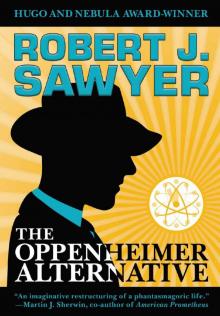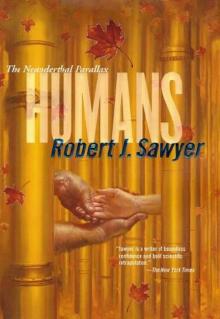- Home
- Robert J. Sawyer
Quantum Night Page 8
Quantum Night Read online
Page 8
Menno thought about that as they walked past the block of stone with the dedication plaques. “No,” he said at last. “Not quite random. You’re right that the majority of our sample group doesn’t have the background noise, but if you look at the test subjects who came from my class—Jim, Tatiana, the others—most of them do have the noise, and . . .”
“Yes?”
Menno continued along, the packed-down snow squeaking underfoot. “Background noise . . .” he said, slowly pursuing the idea as if it were a rabbit that would flee if startled. “In the auditory cortex . . .” His heart was pounding. “Preferentially present in those who study psychology.”
“Well, I always said psych students were a little weird.”
“It’s not just that,” Menno replied. “Psych attracts a certain kind of student: kids trying to make sense of themselves. Cheaper than therapy, you know?”
A single puff of chilled air: “So?”
“So, they’re obviously chewing things over, ruminating, wondering.” He felt his eyebrows colliding with the wool of his cap, and he lowered his voice, as if speaking softly would make the idea sound less crazy. “The background stuff. It isn’t noise.” He shook his head. “It’s—my God! It’s inner monologue—stream of consciousness! It’s the constant background of a normal life, all the stuff you’re thinking inside: I wonder what’s for lunch. Jeez, is it Thursday already? Gotta remember to stop by the store on the way home. Those thoughts—those articulated thoughts—are made of phonemes, too. They’re never spoken, they’re never even subvocalized or mouthed. But they’re words all the same, made up of phonemes. And so the question isn’t—”
“The question isn’t,” said Dominic, coming to a dead halt beneath skeletal branches, “why some people do have background noise in their auditory cortices. The question is why most people do not.”
10
PRESENT
I entered the lecture hall in the aptly named Tier Building, rows of first-year students rising in front of me. Some were looking bright-eyed and bushy-tailed even now, at stupid o’clock in the morning, but most still showed signs of struggling to wake up. Tim Hortons had clearly done dynamite business before class: half the students had red cardboard cups on their swing-up desktops.
I tucked my hands into the pockets of my black denim jeans and strode to the lectern. “Okay, ladies and gentlemen, we’re going to start with a joke. Stop me if you’ve heard this one before.” I smiled and waited until I had their full attention—or, at least, attention from those who usually gave it. “Here goes: why was the road crossed by the chicken?”
I continued to smile at them, but no one laughed. After a few seconds, I said, “Tough room,” and that, at least, merited a few chuckles. “Anybody? What’s the punch line?”
A white girl with long red hair in the third row started to say, “To get to the . . .” But she trailed off, apparently realizing that although that worked when the setup was the normal “why did the chicken cross the road,” it didn’t make sense here.
I tried again: “Anyone? Why was the road crossed by the chicken?”
An Asian boy in the fifth row folded his arms in front of his Winnipeg Jets sweatshirt. “There’s no answer to that, Professor Marchuk.”
“Why not?”
The boy’s tone conveyed that his word choice was deliberate: “Well, this ain’t English class”—and that, too, got some chuckles—“but your joke is in the passive voice. There isn’t anybody deliberately doing anything, so there’s no one to assign the motivation of ‘to get to the other side’ to.”
“Exactly!” I said, delighted, as I always was, when a session got off to a good start. “And you’re right, this isn’t English class; it’s psychology. So let me introduce you to a core psychological concept, namely the notion of agency—the subjective awareness that you are initiating and executing your own actions. And then we’re going to talk about why, although we all believe that we do indeed have agency, perhaps we really don’t . . .”
I returned to my condo, grabbed a shower, put on a wine-colored shirt and black slacks, and drove over to The Forks. Once again, I was listening to the CBC; The World at Six was on.
“—and the stunning news that the leader of the New Democratic Party has chosen not to seek re-election this time out,” Susan Bonner said. “We reached political analyst Hayden Trenholm in Ottawa. Mr. Trenholm, what do you make of his announcement?”
A man’s voice with a hint of a Maritime accent: “The NDP were the front-runners in the 2015 election but stumbled badly under then-leader Tom Mulcair, and his replacement certainly also failed to excite. But if they can come up with someone people from across the political spectrum can get behind, the New Democrats could make some interesting gains. Of course, they’ve been searching in vain for a person like that since Jack Layton passed away in 2011 . . .”
I parked my car and headed out into the cool evening air. I’d made reservations for us at Sydney’s, an upscale place housed in the century-old Grand Trunk Pacific Railway Stable. Kayla was already seated when I got there—gotta love that punctuality—and—what a sweetheart!—she’d already asked the server to bring a vegetarian menu for me. We had a great table by a semicircular window; it arched up from a horizontal sill overlooking the confluence of the Red and Assiniboine Rivers. Kayla was wearing a shimmering blue top and gray pants.
After we’d ordered, I said, “So, at lunch you were talking about the quantum physics of consciousness.”
She took a sip of wine. “That’s right. My research partner is a woman named Victoria Chen. As I said earlier, she’s developed a system that can detect quantum superposition in neural tissue.”
“I’m no physicist, but I thought you couldn’t have quantum effects like that in living things.”
“Oh, it definitely happens in some biological systems. We’ve known since 2007 that there’s superposition in chlorophyll, for instance. Photosynthesis has a ninety-five percent energy-transfer efficiency rate, which is better than anything we can engineer. Plants achieve that by using superposition to simultaneously try all the possible pathways between their light-collecting molecules and their reaction-center proteins so that energy is always sent down the most efficient route; it’s a form of biological quantum computing. Vic was curious about how plants manage that at room temperature while we have to chill our quantum computers to a fraction above absolute zero to get superposition. And, well, as I mentioned at lunch, I’ve long been interested in the Penrose-Hameroff model that says quantum superposition in the microtubules of neuronal tissue is what gives rise to consciousness. So I convinced Vic to let me try her technique on people, to see if there really is superposition in human brains.”
“And?”
“And, oh my God, yes, there is. It’s not quite what Hameroff and Penrose proposed, but they definitely opened the door for this line of work.” She sighed wistfully. “I suspect Vic and I will have to share our eventual Nobel with one of them—they only allow three people on a Nobel, so Stuart and Roger will have to fight it out between themselves.”
“Ha.”
“Yeah, see, they think consciousness occurs in the moments of collapse from superposition to classical physics—that each moment of collapse is a moment of consciousness, forty or so of them per second. It was an interesting theoretical model when they first put it forth in the 1990s, but Victoria has shown that superposition in microtubules, unique among body structures, is maintained indefinitely—indeed, probably permanently.”
I frowned. “But I thought quantum superposition was fragile. Doesn’t it fall apart?”
“Not as far as we can tell. Not ever—or at least not as long as the person is alive.”
“Why not?”
“Vic calls it ‘entanglement inertia,’ and, I’ve got to say that it’s a revolutionary-enough discovery that it might get her the Nobel on her own. See, a single e
lectron will decohere rapidly, falling out of superposition, but, for whatever reason, the countless trillions of superpositioned electrons in a given brain are locked together in a way that defies quantum theory, and so probabilistic laws apply. At any moment, any one of them might wish to decohere back to the classical state, but, unless a majority simultaneously want to, it doesn’t happen. We’ve got computer simulations that show the tipping point never comes, at least not normally. Oh, an external force—an anesthetic, for instance—can cause the superposition to decohere, but without something like that, the superposition never collapses. It just keeps on going on.”
I made an impressed face. “Has she published yet?”
Kayla shook her head. “It’s out for peer review at Neuron.”
“Sounds like a great paper.”
“I’ll send you a preprint. But it’s only the first of several papers; she and I also have one coming up in Physics of Life Reviews.”
I took a sip of my own wine. “Oh? What about?”
“Well, Penrose proposed that each tubulin macromolecule has a single two-lobed hydrophobic pocket with just one free electron. But he also offhandedly remarked that there might actually be multiple hydrophobic pockets, each with its own electron. And that’s exactly what Vic and I have found: there are actually three hydrophobic pockets in each tubulin macromolecule.”
“Okay.”
“And all the tubulin macromolecules in a given brain are quantally entangled, meaning collectively they’re all in the same state: the combination of superpositioned and classical electrons is the same in every tubulin in the brain of a given individual.”
“Ah.”
“That means that each person is in one of eight possible conditions: all three pocketed electrons in the classical-physics state; all three in superposition; or six possible combinations of one or two electrons in the classical state and the remaining ones in superposition.”
“Very cool.”
“Thanks. Now, we don’t think it matters which electrons are in superposition and which aren’t; electrons, like all subatomic particles, are fungible. So that means there are really only four states not eight: no electrons in superposition, any one of the three in superposition, any two in superposition, and all three in superposition. In other words, there’s the classical-physics state, plus three states with quantum superposition: Q1, Q2, and Q3.”
“Got it.”
“And it’s the Q2 state that caused me to look you up; that’s where my research dovetails with yours. I ran a couple of hundred volunteers through Victoria’s beamline—the test doesn’t take long—and found that everybody’s got at least one electron in superposition. Nobody was in the classical-physics state; everyone was either Q1, Q2, or Q3. And the three cohorts are each successively smaller, a 4:2:1 ratio, each group half the size of the one before it. In round numbers, sixty percent of our test subjects had only one electron in superposition; thirty percent—half as many—had any two in superposition; and about fifteen percent had all three in superposition.”
“I suppose it’s like juggling,” I offered. “Easy to keep one ball in the air, harder with two, and a bitch with three.”
“Yeah, that’s our thinking, too. Assuming those ratios hold true for the entire human race, if you think of Earth’s population as seven billion people—it’s really more like 7.7, but for convenience’s sake let’s assume abstinence-only sex education actually worked, and round down—that means there are four billion in the first cohort, two billion in the second, and just one billion in the third.”
“Right.”
“Anyway,” said Kayla, “I was curious if there were any psychological differences between the cohorts, and so I administered a standard five-factor-model personality measure on each subject and—bada-bing!—all our Q2s had scores that correlated with psychopathy.”
“Ah,” I said, finally getting it. “You came up with a triad suggestive of psychopathy: low conscientiousness, low agreeableness, high extraversion.”
“Exactly! Got essentially the same results when I tried HEXACO, too, so we moved on to the Lilienfeld Psychopathic Personality Inventory and the Hare Psychopathy Checklist, and found an almost perfect correlation between psychopathy and having any two of the three electrons in superposition. Didn’t matter which two—that’s how we confirmed the fungibility notion—but if you had two out of three, you were a psychopath.” She raised a hand, palm out. “Not necessarily a violent one, mind you. You were just as likely to be one of those Hare calls ‘a snake in a suit,’ a ruthless businessperson. Still, it’s a clear-cut relationship, just like your microsaccades thing.”
“You said about thirty percent of your test group were Q2s?”
“Yup, and evenly split between men and women.”
“My microsaccades test shows the same percentage and gender balance. Did you get the kind of flak I did about that being a much higher prevalence of psychopathy than is generally assumed?”
She smiled. “We cited you in our paper on that very point, but, yeah, we’re expecting the reviewers from Physics of Life to challenge us on it.”
I nodded. As I’m sure Kayla knew, most older estimates put the prevalence of psychopathy at between one and four percent of the general population of men, and about a tenth of that among women. But those values were due to sampling problems. Take Kent Kiehl, one of Hare’s last grad students, who did the first-ever scans of psychopaths’ brains—great work, that. He did his initial studies at the University of British Columbia, where, with the extraordinary cooperation of the Canadian Department of Corrections, he was able to routinely transfer violent criminals who had scored high on the Hare Checklist to a hospital where they could be scanned by fMRI; the precautions taken against the prisoners escaping were worthy of a Hollywood film.
But when Kent was lured to Yale with a sweetheart offer—he asked for double the salary his colleagues in Canada were getting and was told, “Oh, we can do better than that”—he immediately became frustrated. He’d hoped to work with psychopaths at large in the New Haven community: people with criminal records but now released from prison. But he found—duh!—that psychopaths weren’t good about keeping appointments for scientific experiments, and those rare times they did show up, they were often too drunk or too uncooperative to be of any use.
Anyway, one of the chapters of Kent’s book The Psychopath Whisperer begins by baldly declaring, “Fact: There are over twenty-nine million psychopaths worldwide.” If you flip to the endnote, it turns out he reached that figure by assuming the percentage of psychopaths found in prisons accurately reflected the prevalence of psychopathy in the population as a whole. But the ones behind bars are just the ones dumb enough to get caught; with their skills at manipulation and deception, psychopaths almost certainly are captured at a rate much lower than that of normal people—my pal Devin Becker notwithstanding.
Likewise, Kent claims that there are ten times as many male psychopaths as females. Why? Well, see, he says, there are ten times as many male psychopaths in prison as females ones—which is true, but there are also ten times as many male left-handers in prison, and male redheads, and males who like anchovies on their pizza—simply because there are ten times as many men behind bars as women.
Before my work, and now Kayla’s, no one knew how many psychopaths there actually were. Twenty-nine million? Nuh-uh, Kent. It’s more like two fucking billion—thirty percent of Earth’s population, two out of every seven people.
The waiter came with our entrees. When he was gone, I said, “What about the other two cohorts—you know, just one electron in superposition, or all three in superposition?”
Kayla lifted her shoulders. “I couldn’t discern any difference between Q1s and Q3s. No, as far as we can tell, there are only two types of consciousness, at least from a quantum-mechanical point of view: psychopathic Q2s, and everyone else.”
“Do yo
u think you inherit your state?”
“It doesn’t seem to run in families. Oh, some people are the same state as their parents, siblings, or children, but that’s not disproportionately common. And, as far as we can tell, people don’t change states—we’ve done as much of a longitudinal study as we can so far, and no one has ever switched.”
“Fascinating,” I said. Marveling at the circumstances that had brought us together again after so much time, I added, “Quite a coincidence, you and me both ending up working on psychopathy.”
Kayla’s tone grew cold. “It’s not a coincidence, Jim.”
“What?”
She stared at me, and I met her gaze—until I couldn’t. “I got interested in psychopathy because of you,” she said. “Because of the horrible things you did all those years ago.”
11
TWO DECADES AGO
“GOOD evening, Jim. Thanks for coming in again.”
Jim Marchuk was carrying a plastic bag with the green McNally Robinson logo. “No problem, Professor Warkentin. Bit surprised anyone’s working on New Year’s Eve.”
“Oh, Christmas break is my favorite time on campus,” Menno said. “Peace and quiet. Summers are great, too—the campus is mostly empty, and the weather’s nicer then, but Christmas is the best; the place is dead.”
Jim’s tone was light. “Universities would be wonderful if it weren’t for all those pesky students.”
“No, no, no,” said Menno. “It’s faculty that drive me up the walls. Departmental meetings, committee meetings, so-and-so’s retirement dinner, somebody else’s birthday lunch. Here, with almost everyone away, a body can finally concentrate.”
“Huh,” said Jim.

 The Oppenheimer Alternative
The Oppenheimer Alternative Factoring Humanity
Factoring Humanity The Shoulders of Giants
The Shoulders of Giants Stream of Consciousness
Stream of Consciousness End of an Era
End of an Era The Terminal Experiment
The Terminal Experiment Far-Seer
Far-Seer Mindscan
Mindscan You See But You Do Not Observe
You See But You Do Not Observe Star Light, Star Bright
Star Light, Star Bright Wonder
Wonder Wiping Out
Wiping Out Flashforward
Flashforward Above It All
Above It All Frameshift
Frameshift The Neanderthal Parallax, Book One - Hominids
The Neanderthal Parallax, Book One - Hominids Foreigner
Foreigner Neanderthal Parallax 1 - Hominids
Neanderthal Parallax 1 - Hominids Relativity
Relativity Identity Theft
Identity Theft Hybrids np-3
Hybrids np-3 Foreigner qa-3
Foreigner qa-3 WWW: Watch
WWW: Watch Calculating God
Calculating God The Terminal Experiment (v5)
The Terminal Experiment (v5) Peking Man
Peking Man The Hand You're Dealt
The Hand You're Dealt Illegal Alien
Illegal Alien Neanderthal Parallax 3 - Hybrids
Neanderthal Parallax 3 - Hybrids Fossil Hunter
Fossil Hunter WWW: Wonder
WWW: Wonder Iterations
Iterations Red Planet Blues
Red Planet Blues Rollback
Rollback Watch w-2
Watch w-2 Gator
Gator Triggers
Triggers Neanderthal Parallax 2 - Humans
Neanderthal Parallax 2 - Humans Wonder w-3
Wonder w-3 Wake
Wake Just Like Old Times
Just Like Old Times Wake w-1
Wake w-1 Fallen Angel
Fallen Angel Hybrids
Hybrids Hominids tnp-1
Hominids tnp-1 Far-Seer qa-1
Far-Seer qa-1 Starplex
Starplex Hominids
Hominids Identity Theft and Other Stories
Identity Theft and Other Stories Watch
Watch Golden Fleece
Golden Fleece Quantum Night
Quantum Night Fossil Hunter qa-2
Fossil Hunter qa-2 Humans np-2
Humans np-2 Biding Time
Biding Time